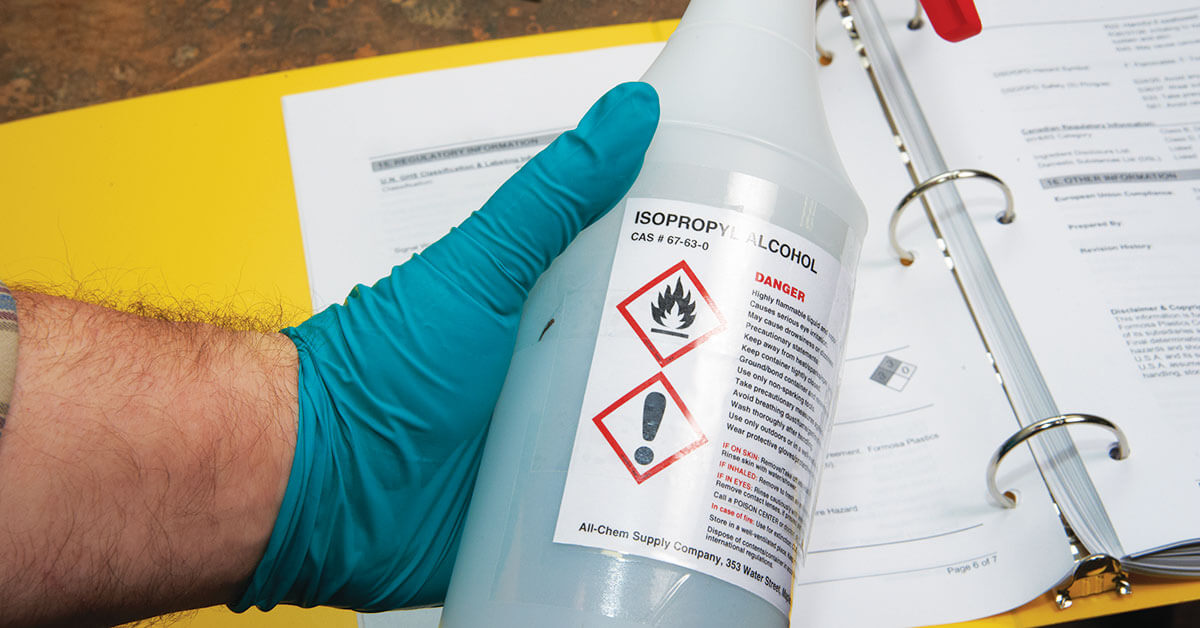Labeling secondary containers
Date Posted: 02/03/2019

If an employee transfers a cleaning solvent from its original container into a smaller, secondary container does it have to be labeled? What if that same employee leaves the secondary container and starts working in a different area, no longer controlling the container during his or her shift, and does not return to use up the product or empty the container?
It depends...
The hazard communication ("HazCom") standard at 1910.1200(f)(8) says, in part, "the employer is not required to label portable containers into which hazardous chemicals are transferred from labeled containers, and which are intended only for the immediate use of the employee who performs the transfer." If the chemical is used in the same shift by the same person, you are not required to label the secondary container.
In the second instance, in which the container is left unattended and may be used by an employee on another shift, the container does need to be labeled because it does not fall under the "immediate use of the employee who performs the transfer."
What information is required on secondary container labels?
If the chemical is going to be used only "in house," then the container is to be labeled in accordance with 1910.1200(f)(6). Label it with the product identifier, words, pictures, symbols, or a combination thereof.
You can use HMIS or NFPA labels, or your own system, for in-house container labels as stated in 1910.1200(f)(7).
It is not a requirement that a label show the hazard statements, precautionary statements, or first aid information on the label as stated in 1910.1200(f)(6).
How does the HazCom standard define "hazardous chemical"?
1910.1200(c) gives the definition of hazardous chemical as "any chemical which is classified as a physical hazard or a health hazard, a simple asphyxiant, combustible dust, pyrophoric gas, or hazard not otherwise classified."
Health hazard, according to the regulations, means a chemical which is classified as posing one of the following hazardous effects: acute toxicity (any route of exposure); skin corrosion or irritation; serious eye damage or eye irritation; respiratory or skin sensitization; germ cell mutagenicity; carcinogenicity; reproductive toxicity; specific target organ toxicity (single or repeated exposure); or aspiration hazard.
Physical hazard is defined as a chemical that is classified as posing one of the following hazardous effects: explosive; flammable (gases, aerosols, liquids, or solids); oxidizer (liquid, solid, or gas); self-reactive; pyrophoric (liquid or solid); self-heating; organic peroxide; corrosive to metal; gas under pressure; or in contact with water emits flammable gas.
The HazCom standard at 1910.1200(b)(1) requires chemical manufacturers or importers to classify the hazards of chemicals which they produce or import.
How Safety Management Suite Can Help
The Chemical Management feature in the J. J. Keller® SAFETY MANAGEMENT SUITE delivers unlimited access to a wide range of cutting-edge chemical management tools. Accessible at any time from any mobile device, it allows you to easily track, label, manage and report on chemical hazards throughout your facility.
- Develop and maintain a list of approved chemicals used throughout your facility
- Enjoy unlimited access to multi-language SDSs and easily request SDSs en masse
- Autogenerate GHS-compliant HazCom labels
- Streamline your operations with easy employee access to all of your SDSs
Additionally, if you get stumped by a workplace safety question, check out our Expert Help tool where you can ask a private and secure compliance question to our safety experts.
E-mail Newsletter
Sign up to receive the weekly EHS Insider email newsletter for safety articles, news headlines, regulatory alerts, industry events, webcasts, and more.